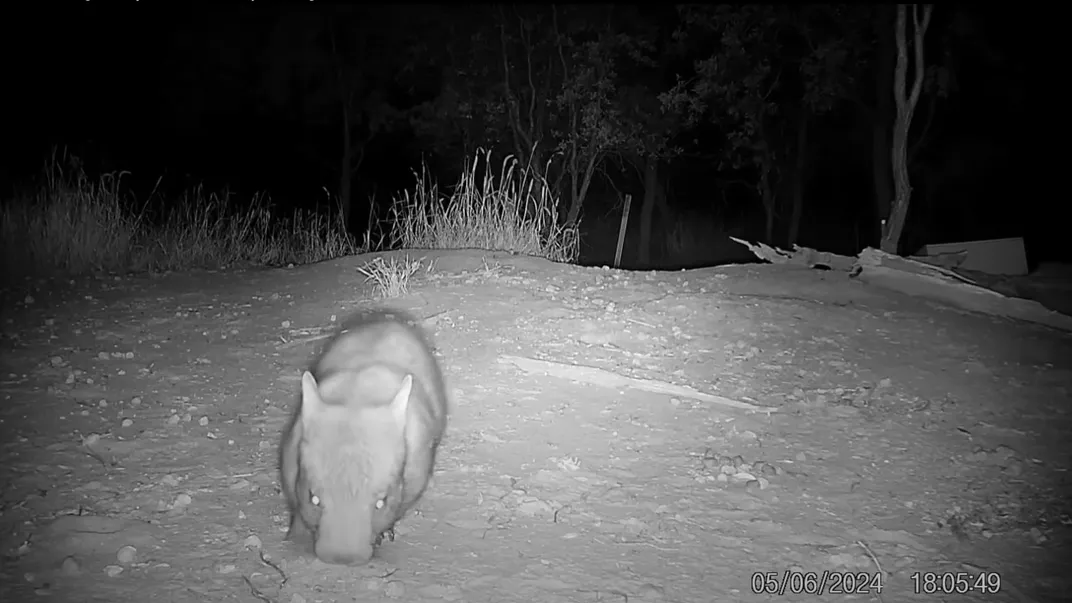See Rare Footage of a Young Wombat Caught on a Wildlife Camera in Australia
Just 400 northern hairy-nosed wombats remain in the wild, and conservationists say the new videos signal the critically endangered species’ breeding success
:focal(350x250:351x251)/https://tf-cmsv2-smithsonianmag-media.s3.amazonaws.com/filer_public/5e/92/5e923224-ccde-4ff2-94f9-e3e3a6ba9126/website-body-size-2024-08-15t113326833.png)
Ecologist Andy Howe was sifting through more than 100 hours of footage from a wildlife camera when a bit of movement caught his eye. As he looked more closely at the screen, he saw a critically endangered juvenile northern hairy-nosed wombat emerge from a burrow and amble around.
Howe and his colleagues at the Australian Wildlife Conservancy were elated by the video, which was captured at the Richard Underwood Nature Refuge in southwest Queensland in June.
“It’s very gratifying to know that one of the world’s most critically endangered animals is doing well and breeding within the safety of the fenced area,” Howe says in a statement. “Although this isn’t the first joey born at the refuge, it is the first juvenile spotted for a few years.”
Conservationists can’t tell exactly how old the creature is, but it appears to be healthy with “a smooth consistent coat and no obvious signs of injury,” according to the statement.
Fifteen years ago, conservationists began translocating northern hairy-nosed wombats to the fenced refuge in a bid to help the struggling species rebound. The recent recording suggests the refuge’s wombat population, estimated to be 15 individuals, is thriving.
“The wombat is quite robust, indicating that it is feeding well and getting enough nutrition,” Howe adds in the statement. “Overall, this bit of footage tells us a lot about the state of the [refuge] population, showing us that the wombats have the right conditions and feel comfortable enough to breed.”
Northern hairy-nosed wombats (Lasiorhinus krefftii) once roamed throughout Australia, from northern Victoria to New South Wales to central Queensland. But after European colonizers settled on the continent, they began systematically killing the creatures, and their livestock competed with wombats for food.
By the late 1990s, just 35 northern hairy-nosed wombats were left, at a small reserve in Queensland. Since then, conservation efforts have helped boost the population to around 400 individuals. Today, only three groups of northern hairy-nosed wombats remain—the translocated animals at the Richard Underwood Nature Refuge, plus groups in Epping Forest National Park and Powrunna State Forest.
Another rare clip, recorded about a month later at Richard Underwood Nature Refuge, shows a young wombat interacting with a short-beaked echidna. While the echidna calmly walks across the dirt, the wombat starts flinging dirt and spinning in frantic circles.
“It’s a nervous wombat and a happy echidna,” says Tim Flannery, a biologist with the Australian Museum in Sydney, to New Scientist’s James Woodford.
Both animals are behaving naturally, which Flannery describes as “fantastic.”
“This is very heartening to see these wombats doing so well,” he tells New Scientist, adding that conservationists should try to establish additional wombat populations based on the success of the Richard Underwood Nature Refuge translocation.
The northern hairy-nosed wombat is one of three wombat species, all found in Australia. The others are the common wombat (Vombatus ursinus) and the Southern hairy-nosed wombat (Lasiorhinus latifrons).
These stocky marsupials have sharp claws and powerful limbs that help them dig into the ground. They live in elaborate underground burrows that also provide shelter, food and water for other animals.
“Northern hairy-nosed wombats are so rare, most people have never even heard of them,” Joey Clarke, senior science communicator with the Australian Wildlife Conservancy, tells Newsweek’s Tom Howarth. “But thanks to dedicated conservation efforts, including controlling feral animals and establishing multiple new conservation sites, their trajectory is looking a lot brighter today.”
/https://tf-cmsv2-smithsonianmag-media.s3.amazonaws.com/accounts/headshot/SarahKuta.png)


/https://tf-cmsv2-smithsonianmag-media.s3.amazonaws.com/accounts/headshot/SarahKuta.png)